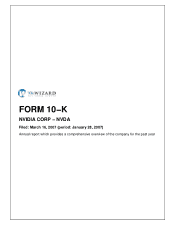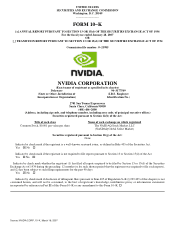NVIDIA 2007 Annual Report Download - page 8
Download and view the complete annual report
Please find page 8 of the 2007 NVIDIA annual report below. You can navigate through the pages in the report by either clicking on the pages listed below, or by using the keyword search tool below to find specific information within the annual report.
Original equipment manufacturers, or OEMs, original design manufacturers, or ODMs, add−in−card manufacturers, system
builders and consumer electronics companies worldwide utilize NVIDIA processors as a core component of their entertainment and
business solutions. Our GPUs are designed to deliver performance and visual quality for PC−based applications such as
manufacturing, science, e−business, entertainment and education. Our MCPs perform demanding multimedia processing for secure
broadband connectivity, communications and storage. Our handheld GPUs deliver a quality visual experience by accelerating graphics
and video applications while implementing design techniques that result in high performance and relatively low power consumption.
Our Business
GPU Business
The combination of our GeForce 6, GeForce 7 and GeForce 8 series of GPUs and our Scalable Link Interface, or SLI, technology
and NVIDIA Quadro professional solutions has created a new class of gaming PCs and professional workstations. SLI technology
takes advantage of the increased bandwidth of the peripheral component interconnect, or PCI, Express bus architecture to allow up to
four NVIDIA GPUs to operate in a single PC or up to two NVIDIA GPUs to operate in a notebook PC or professional workstation. In
fiscal 2007, we announced PureVideo High−Definition, or HD technology, a combination of hardware acceleration from an NVIDIA
GPU, high definition movie player integration and High−Bandwidth Digital Content Protection or HDCP, feature support, to enable
manufacturers and consumers to build PCs that can play High−Definition Digital Video Disc, or HD DVD, or Blu−ray movies. In
November 2006, we launched the GeForce 8800, the industry's first GPU to support the new Microsoft DirectX 10 Application
Programming Interface, or API. DirectX 10 is a new API for the Microsoft Windows Vista operating system, or Vista, and includes
many new features, such as a geometry shader. GeForce 8800 is the first DirectX 10 GPU based on Unified Shader architecture, which
can adapt its computation resources to changing vertex and pixel shading workload from scene to scene. We also announced Compute
Unified Device Architecture, or CUDA, a new mode of operation on GPUs where the computational power of the GPU can be utilized
for computation−intensive applications.
Technology and market leadership in this generation of GPUs continues to be a key element of our corporate strategy. The
combination of the programmable Unified Shader GPU with Microsoft Corporation's, or Microsoft's, DirectX 10 high−level shading
language is known as DirectX 10 GPUs. Combined with the ability to directly access the GPU via the new Vista applications from
Microsoft Office to Web 2.0 applications can now incorporate 3D effects. In fiscal 2007, our strategy was to extend our architectural
and technology advantage with our second−generation GPUs to support DirectX 9.0 Shader Model 3.0, the GeForce 7 Series GPUs.
By extending our leadership position in the performance segment with the production release of the GeForce 7900 in June 2006, we
grew our market share from 79% to 85%, according to the Mercury Research Fourth Quarter 2005 and 2006 PC Graphics Reports,
respectively.
The NVIDIA Quadro brand has become the benchmark of performance and compatibility for the professional industry. NVIDIA
Quadro is recognized by many as the standard for professional graphics solutions needed to solve many of the world's most complex
visual computing challenges in the manufacturing, entertainment, medical, science, and aerospace industries. In fiscal 2007, we
introduced NVIDIA Quadro Plex, a new category of visual computing solutions that brings a level of graphics scalability and
processing density. In November 2006, we began seeding the industry with our GeForce 8 GPU, enabled with CUDA, a technology
and compiler that, for the first time, allows for programmers to write C language applications for GPUs. GeForce 8 and CUDA will
enable a new class of high performance computing we call “GPU Computing.” With CUDA−enabled GPUs, engineers and scientists
will be able to harness programmable GPUs in PCs to solve mathematically−intensive problems that were previously cost prohibitive.
MCP Business
The NVIDIA nForce family of products represents our MCPs for Advanced Micro Devices, Inc., or AMD, and Intel Corporation,
or Intel,−based desktop, notebook, professional workstations and servers. Our strategy for MCPs aligns with what we anticipate will
drive growth in the MCP segment such as multi−core, ever−increasing−speed networking and storage technologies, and integration of
complex features such as virtualization, security processing, network processing and more. The In−Stat Trendy Chipset for the x86
Processor Report projects strong growth for PC chipsets through the end of this decade from $7.6 billion in calendar 2006 to over $10
billion in calendar 2009.
In fiscal 2007, we began production shipments of our single−chip motherboard GPUs for AMD−based PCs. We are now the
second largest core logic supplier in the world, according to the Mercury Research Fourth Quarter 2006 PC Graphics Report. We are
the largest supplier of AMD 64 chipsets with 53% segment share. NVIDIA nForce MCP unit shipments for AMD64−based CPUs
increased over 113% calendar year−over−calendar year, based on the Mercury Research Fourth Quarter 2006 PC Processor Forecast
Report. 2
Source: NVIDIA CORP, 10−K, March 16, 2007





















